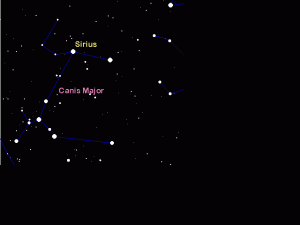Laethe Madrúla an tSamhraidh (ca. 3 Iúil go ca. 11 Lúnasa) Posted by róislín on Jul 8, 2011 in Uncategorized
(le Róislín)
Before we return to our discussion of 5th-declension nouns, let’s talk about one more ábhar tráthúil: laethe madrúla an tsamhraidh.
Three basic words, somewhat disguised by plural endings, a t-prefix, and a genitive-case ending.
Laethe [LAY-huh], pl., from “lá,” day; sometimes this plural form is given as “laethanta.”
Madrúla [MAHD-rool-uh], pl. from “madrúil,” doggish, doglike, doggy, canine, canicular, or for our purposes here, simply “dog,” used as an adjective
an tSamhraidh [un TOW-ree], of the summer, from “samhradh” [SOW-ruh] summer. In both cases here the “tow” and “sow” are pronounced as in IPA /au/, or, for real-world examples, like the “tau” of the Tory Island tau-cross or the “Tao” of Lao Tzu, Master Zhuang, and Pooh, and like “sow” as in a female pig or the “sow-“ of “sowkar (soucar).” In other words, not with the “oh” sound of “tow-truck,” “tow-headed,” “tow-rope” or a “tow-holding distaff,” nor like the verb “to sow” as in seeds (or wild oats), or for that matter, the Irish word “só” (comfort).
So, yes, it’s the “dog days,” aka diēs caniculārēs, la canicula, la canicule (which also means a “heat wave”), Hondsdagen, Hundstage, an t-iuchar (from “reull an iuchair”), dyddiau’r cŵn, and mätäkuu.
Depending on what source you use for the dates, they are already upon us or are starting. The earliest starting date is usually around 3 Iúil, but a somewhat more widespread interpretation has them starting around 24 Iúil in the Leathsféar Thuaidh.
I’m not sure how many léitheoirí on this liosta are actually from “an Leathsféar Theas,” but for lucht na bhFritíortha and their cóhoirt laisteas den Mheánchiorcal, the dátaí would be Eanáir go tús mhí an Mhárta.
Why is aimsir the bhrothallach associated especially with madraí? It’s due to Sirius (Réalta an Mhadra), which is relatively close to the sun and which is thought to bring the hot weather to the earth. Sirius is the brightest star in the réaltbhuíon Canis major and it’s also an réalta is gile in the night sky. The Romans had noted that during the hottest part of the summer, the star Sirius would rise go héileacach (with the sun) and would be visible for a few minutes until the light of the sun got too bright and would outshine Sirius.
Whatever the exact dates of the dog dogs might be, chances are, if you’re reading this in sa Leathsféar Thuaidh that the aimsir could be described as te, brothallach, marbhánta, and “*doldramach.” In fact, an alternate and unofficial explanation of the term “dog days” is that the weather is so hot that people just laze around like dogs.
Aaahhh, in the good old canicular days!
Gluais: brothallach, sultry, hot; doldramach, doldrum-y (the Irish is likely my own coinage, based on “na Doldrama;” the English adjective is not standard but is well-enough attested ar an Idirlíon); na Fritíortha, the Antipodes; héileacach, heliac; is gile, brightest; laisteas de, south of; marbhánta, dull, stagnant, oppressive; theas [hass], southern, south; thuaidh [HOO-ee], northern, north; tráthúil, timely; tús, start

Build vocabulary, practice pronunciation, and more with Transparent Language Online. Available anytime, anywhere, on any device.





Leave a comment: